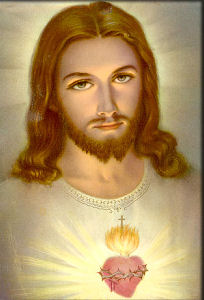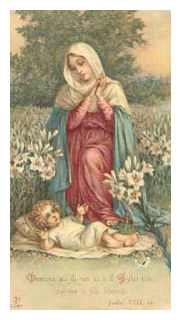 (from the picture that hangs in our home)
(from the picture that hangs in our home)
As you probably already know, the month of June is dedicated to the Sacred Heart of Jesus.
It seems hard to believe that in these ultra-modern days and the secularistic society that surrounds us, that traditinal Catholic devotions, like the devotions to the Sacred Heart of Jesus are being practiced by more and more Catholic families.
What is the history of this devotion?
Well, Jesus appeared to a seventeen year old girl named of Margaret Mary Alacoque. He appeared to her as He was after He had been scourged. Following the apparition of our Lord, Margaret Mary entered the Order of the Visitation.
She had a very strong devotion to our Lord in the Blessed Sacrament and she loved Him very much.
Jesus showed her His Sacred Heart in four visions. The flames that are depicted in pictures of Jesus' Sacred Heart are to remind us of his burning love for each and every one of us and of His desire for us to love Him in return.
The crowns of thorn that surround His Sacred Heart are to remind us of sacrifice for the reparation of sin.
Jesus made twelve promises to St. Margaret Mary for those who honored His Sacred Heart.
1. I will give them all the graces necessary for their state of life.
2. I will give peace in their families.
3. I will console them in all their troubles.
4. They shall find in My Heart an assured refuge during life and especially at the hour of death.
5. I will pour abundant blessings on all their undertakings.
6. Sinners shall find in My Heart the source and infinite ocean of mercy.
7. Tepid souls shall become fervent.
8. Fervent souls shall speedily rise to great perfection.
9. I will bless the homes in which the image of My sacred Heart shall be exposes and honored.
10. I will give to priests the power to touch the most hardened hearts.
11. Those who propagate this devotion shall have their name written in My Heart, and it shall never be effaced.
12. The all-powerful love of My Heart will grant to all those who shall receive Communion on the First Friday of nine consecutive months the grace of final repentance; they shall not die under My displeasure, nor without receiving their Sacraments; My Heart shall be their assured refuge at that last hour.
Another way to honor the Sacred Heart of Jesus is have to your home enthroned. When your home is enthroned, you are making Jesus the King of your family.
For more information on these devotions, check out the following:
EWTN's Sacred Hearts Page
Fr. John Hardon's Devotion to the Holy Eucharist Advances Devotion to Jesus' Person
HOME ENTHRONEMENT
EWTN Family Enthronement Ritual
Steve Woods' Beginning a Men's Apostolate with Home Enthronements of the Sacred Heart
(Brief history of the Sacred Heart is by Father Lovasik)
The most important Person on earth is a mother. She cannot claim the honor of having built Notre Dame Cathedral. She need not. She has built something more magnificent than any cathedral – a dwelling place for an immortal soul, the tiny perfection of her baby's body¦ The angels have not been blessed with such a grace. They cannot share in God's creative miracle to bring new saints to Heaven. Only a human mother
can. Mothers are closer to God the Creator than any other creature; God joins forces with mothers in performing this act of creation… What on God's good earth is more glorious than this: to be a mother.
Cardinal Mindszenty of Hungary
Thanks to Sue of Catholic Community for sharing the following.
A mother cannot always directly influence a son or daughter whose faith or moral conduct is at risk, but at any time of the day or night she can use the invisible communication network of the guardian angels. An angel, mobilized by his mother, can suddenly remind a young man of some resolution or promise. And this reminder can be of decisive importance. Sometimes it
takes very little to influence an indecisive will. The guardian angels are there precisely to serve men as they make their way towards God.
Kate
Thank you Sue of Catholic Community.
Blessed are the Mothers who love God, for their children shall
not be ignorant of their Creator and His plans concerning them.
Blessed are the Mothers who love the word of God, for their
children shall know of the way, the truth and the life.
Blessed are the Mothers who love the house of God, for their
children shall enter there and sit with them in the presence of God.
Blessed are the Mothers who love to pray, for their children
shall feel the power of prayer and many shall find salvation.
Blessed are the Mothers who love to give to the cause of Christ,
for their children shall become tithers and supporters of the Kingdom of God.
Blessed are the Mothers who love the family altar, for they
shall have their reward in this world and in the world to come.
Blessed are the Mothers who love to speak kind words to their
neighbor's children, for thereby they shall win
other boys and girls besides their own to Jesus Christ.
Blessed are the Mothers who love to be companions to their
children, for they shall be called understanding Mothers.
Blessed are the Mothers who love to fight life's battles
bravely with a strong and steadfast faith in God, for their
children shall know where to find strength in time of need.
Blessed are the Mothers who, when they are old and gray,
can look back upon memory's wall with no regret and can say,
"I brought my children up in the fear of the Lord."
Theirs are the mansions in glory.
Author unknown
 From
From BeliefNet
A Mary Garden is a garden dedicated to Mary, the Mother of God. In a Mary Garden, which can be as small as a clay pot or as large as a city block, a statue of Mary is surrounded by herbs and flowers related to her through legends or naming.
Your personal Mary Garden can grow in a secluded corner of your garden or backyard, or be open to the neighborhood in front of your house. It can be in a pot on your windowsill, on a patio, or on an indoor table.
A Mary Garden can be formal or wild, sunny or shady, and contain annuals and perennials, herbs, ground covers, and shrubs. It can be planted with bulbs to bloom in the early spring, flowering plants that continue into the fall, and evergreens that give color in winter.
Mary's image may be a statue, plaque, holy card, or icon. Ann Duffy of Annapolis, Md., painted the likeness of Mary's face from a holy card onto a piece of wood and waterproofed it for her outdoor garden. A large concrete statue of Mary, found in a garden-ornaments shop, graces my own Mary Garden.
The location, size, and soil of the site will determine what can be planted in an outdoor garden. After that, personal preference, and sometimes Divine Providence, is the guide. Since the Mary names of hundreds of flowers and herbs have survived--Our Lady's Shoes for columbines, Mary's Tears for lilies of the valley, and so forth (see the main story for more)--your garden may contain many of your favorite flowers, planted with the intention of honoring Mary and representing her many attributes. An indoor garden may be planted in a dish, planter, glass, or fishbowl.
----------------------
Although I do not know the original source, the following which goes into a little more detail, was shared by Kaylan of Catholic Community.
Mary Garden
The joy over the appearance of new plants and flowers in spring prompted man to attribute to them a special power of protection and healing. People planted special spring flower gardens; they brought branches of early-blossoming plants, like pussy willows, into their homes; they decorated themselves and their living rooms with wreaths of flowers and clusters of blossoms. A striking Christian variation of these nature rites was the medieval custom of planting "Mary gardens," which were made up of all the flowers and herbs that are ascribed by love and legend as a special tribute to the Blessed Virgin. This charming and inspiring tradition has been revived in many places in Europe and more recently in this country.
DIRECTIONS
In a typical Mary garden the statue of the Madonna occupies a place of honor, either in the center or in a grotto against the wall, with, usually, a birdbath or bubbling fountain built in front of it. Some of the more familiar plants of the many that belong in a typical Mary garden are:
Columbine and Trefoil are said to have sprung forth at the touch of Mary's foot, and consequently bear the popular names Our Lady's shoes or Our Lady's slippers.
Marigold (Mary's bud) has bell-shaped blossoms of vivid yellow. An old legend says, "Her dresses were adorned with Marigold." This flower was used to decorate her shrines for the Feast of the Annunciation (March 25) and during the month of May.
Lily-of-the-valley (Our Lady's tears). This delicate flower is still widely used in Germany, there it is called Maiglockchen (May bells), to decorate the Mary shrines in churches and homes during the Virgin's month (May).
Foxgloves thrive in moist and shaded places; they blossom in many colors and present a most attractive sight with their clusters of little bells, which were called Our Lady's thimbles in medieval times.
Snowdrop. This charming flower is the first herald of spring in Europe. It often blossoms as early as Candlemas (February 2) between batches of melting snow; hence the name. In Germany it is called "Snow bell" (Schneeglocklein). Little bouquets of snowdrops are the first floral tribute of the year at the shrines of the Madonna on Candlemas. It is a popular emblem of Mary's radiant purity and of her freedom from any stain of sin.
Lily. This stately and dignified flower has been associated from ancient times with Jesus and Mary, and is called Madonna lily in many parts of Europe. At Easter its brilliant and fragrant blossoms symbolize the radiance of the Lord's risen life. Later in the year it is used to decorate the shrines of Mary, especially on July 2, the Feast of the Visitation. It also is an old and traditional symbol of innocence, purity, and virginity.
Rosemary produces delicate and fragrant blossoms of pale blue color in early spring. according to legend, the plant originally bloomed in white; however, it turned blue (Mary's color) in reward for the service it offered when Our Lady looked for some bush on which to spread her Child's tiny garments after having washed them on the way to Egypt. The bushes do not grow very tall but as they grow older they spread out and thicken, forming a dense bush. There is an old superstition that "the rosemary passeth not commonly the height of Christ when he was on earth."
Violets are dedicated to Mary as symbols of her humility. They are said to have blossomed forth outside her window when she spoke the words, "Behold, I am a handmaid of the Lord." Leaving her, the angel of God blessed the little flowers in passing, thus endowing them with the tenderest and most beautiful fragrance of all plants.
Roses were associated with Mary from early times. Saint Dominic (1221) is credited with the spreading of the familiar devotion called the "Rosary (rosarium) of the Blessed Virgin Mary." The word "rosary" originally meant a rose garden but was later used in the sense of "rose garland." Three colors are especially consecrated to Mary: white roses as symbols of her joys, red roses as emblems of her sufferings, and yellow (golden) roses as heralds of her glories.


